
The Senegal River is a 1,086 km (675 mi) long river in West Africa; much of its length marks part of the border between Senegal and Mauritania. It has a drainage basin of 270,000 km2 (100,000 sq mi), a mean flow of 680 m3/s (24,000 cu ft/s), and an annual discharge of 21.5 km3 (5.2 cu mi). Important tributaries are the Falémé River, Karakoro River, and the Gorgol River. The river divides into two branches once it passes Kaédi The left branch, called the Doué, runs parallel to the main river to the north. After 200 km (120 mi) the two branches rejoin a few kilometers downstream of Podor.
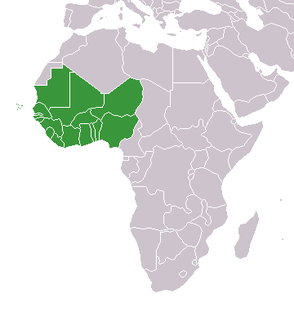
West Africa or Western Africa is the westernmost region of Africa. The United Nations defines Western Africa as the 16 countries of Benin, Burkina Faso, Cape Verde, The Gambia, Ghana, Guinea, Guinea-Bissau, Ivory Coast, Liberia, Mali, Mauritania, Niger, Nigeria, Senegal, Sierra Leone, and Togo, as well as Saint Helena, Ascension and Tristan da Cunha. The population of West Africa is estimated at about 419 million people as of 2021, and at 381,981,000 as of 2017, of which 189,672,000 are female and 192,309,000 male. The region is demographically and economically one of the fastest growing on the African continent.

The Sahel is a region in North Africa. It is defined as the ecoclimatic and biogeographic realm of transition between the Sahara to the north and the Sudanian savanna to the south. Having a hot semi-arid climate, it stretches across the south-central latitudes of Northern Africa between the Atlantic Ocean and the Red Sea.

The desert wheatear is a wheatear, a small passerine bird that was formerly classed as a member of the thrush family Turdidae, but is now more generally considered to be an Old World flycatcher (Muscicapidae). It is a migratory insectivorous species, 14.5 to 15 cm in length. Both western and eastern forms of the desert wheatear are rare vagrants to western Europe. The western desert wheatear breeds in the Sahara and the northern Arabian peninsula. The eastern race is found in the semi-deserts of Central Asia and in winter in Pakistan and northeast Africa.

Méduse was a 40-gun Pallas-class frigate of the French Navy, launched in 1810. She took part in the Napoleonic Wars during the late stages of the Mauritius campaign of 1809–1811 and in raids in the Caribbean.

The Sahara is a desert on the African continent. With an area of 9,200,000 square kilometres (3,600,000 sq mi), it is the largest hot desert in the world and the third-largest desert overall, smaller only than the deserts of Antarctica and the northern Arctic.

The Raft of the Medusa – originally titled Scène de Naufrage – is an oil painting of 1818–19 by the French Romantic painter and lithographer Théodore Géricault (1791–1824). Completed when the artist was 27, the work has become an icon of French Romanticism. At 491 by 716 cm, it is an over-life-size painting that depicts a moment from the aftermath of the wreck of the French naval frigate Méduse, which ran aground off the coast of today's Mauritania on 2 July 1816. On 5 July 1816, at least 147 people were set adrift on a hurriedly constructed raft; all but 15 died in the 13 days before their rescue, and those who survived endured starvation and dehydration and practiced cannibalism. The event became an international scandal, in part because its cause was widely attributed to the incompetence of the French captain.

Auguste René Caillié was a French explorer and the first European to return alive from the town of Timbuktu. Caillié had been preceded at Timbuktu by a British officer, Major Gordon Laing, who was murdered in September 1826 on leaving the city. Caillié was therefore the first to return alive.
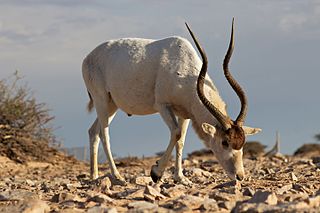
The addax, also known as the white antelope and the screwhorn antelope, is an antelope native to the Sahara Desert. The only member of the genus Addax, it was first described scientifically by Henri de Blainville in 1816. As suggested by its alternative name, the pale antelope has long, twisted horns – typically 55 to 80 cm in females and 70 to 85 cm in males. Males stand from 105 to 115 cm at the shoulder, with females at 95 to 110 cm. They are sexually dimorphic, as the females are smaller than the males. The colour of the coat depends on the season – in the winter, it is greyish-brown with white hindquarters and legs, and long, brown hair on the head, neck, and shoulders; in the summer, the coat turns almost completely white or sandy blonde.
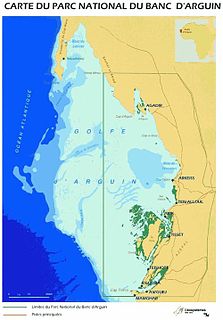
The Bay of Arguin is a bay on the Atlantic shore of Mauritania.

The Banc d'Arguin National Park of Bay of Arguin lies in Western Africa on the west coast of Mauritania between Nouakchott and Nouadhibou. The World Heritage Site is a major site for migratory birds and breeding birds, including flamingos, pelicans and terns. Much of the breeding is on sand banks including the islands of Tidra, Niroumi, Nair, Kijji and Arguim. The surrounding waters are some of the richest fishing waters in western Africa and serve as nesting grounds for the entire western region.
Le Radeau de la Méduse is a French film by Iranian film director Iradj Azimi. It is based on the 1816 wreck of the French frigate Méduse, and the 1819 painting Le Radeau de la Méduse by Jean-Louis André Théodore Géricault which depicts the event. Filming began in 1987, but was interrupted by Hurricane Hugo in September 1989, which delayed completion of the film until the following year. Distribution of film then languished for several years, until Azimi cut his wrist in front of officials of the French Ministry of Culture.
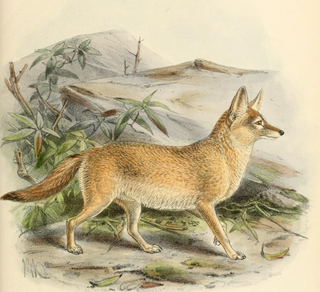
The pale fox is a species of fox found in the band of African Sahel from Senegal in the west to Sudan in the east. It is one of the least studied of all canid species, in part due to its remote habitat and its sandy coat that blends in well with the desert-like terrain.
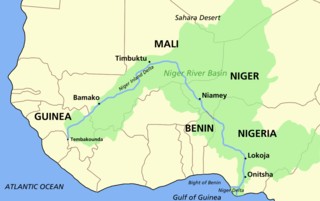
The Association for Promoting the Discovery of the Interior Parts of Africa, founded in London on 9 June 1788, was a British club dedicated to the exploration of West Africa, with the mission of discovering the origin and course of the Niger River and the location of Timbuktu, the "lost city" of gold. The formation of this group was effectively the "beginning of the age of African exploration".
Mauritania's wildlife has two main influences as the country lies in two Biogeographic realms, the north sits in the Palearctic which extends south from the Sahara to roughly 19° North and the south in the Afrotropic realms. Additionally Mauritania is important for numerous birds which migrate from the Palearctic to winter there.
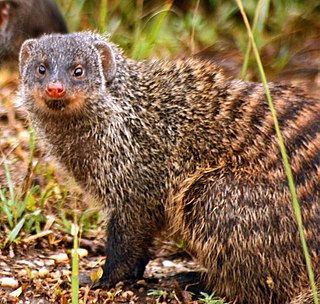
The wildlife of Senegal consists of the flora and fauna of this nation in West Africa. Senegal has a long Atlantic coastline and a range of habitat types, with a corresponding diversity of plants and animals. Senegal has 188 species of mammals and 674 species of bird.
The gracile tateril or slender gerbil is a species of rodent found in Burkina Faso, Chad, Gambia, Ghana, Guinea, Ivory Coast, Mali, Niger, Nigeria, Senegal, Togo, and possibly Cameroon. Its natural habitats are dry savanna, arable land, pastureland, and rural gardens. It is a common species, sometimes considered an agricultural pest, and the International Union for Conservation of Nature has rated its conservation status as being of "least concern".
Kellen's dormouse is a species of rodent in the family Gliridae. It is native to tropical Africa where its range extends from the Gambia and Senegal to Kenya and Tanzania. Its natural habitats are subtropical or tropical dry forests, and moist or dry savannah.
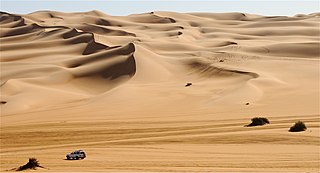
A desert is a barren area of landscape where little precipitation occurs and, consequently, living conditions are hostile for plant and animal life. The lack of vegetation exposes the unprotected surface of the ground to denudation. About one-third of the land surface of the Earth is arid or semi-arid. This includes much of the polar regions, where little precipitation occurs, and which are sometimes called polar deserts or "cold deserts". Deserts can be classified by the amount of precipitation that falls, by the temperature that prevails, by the causes of desertification or by their geographical location.














